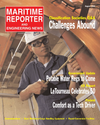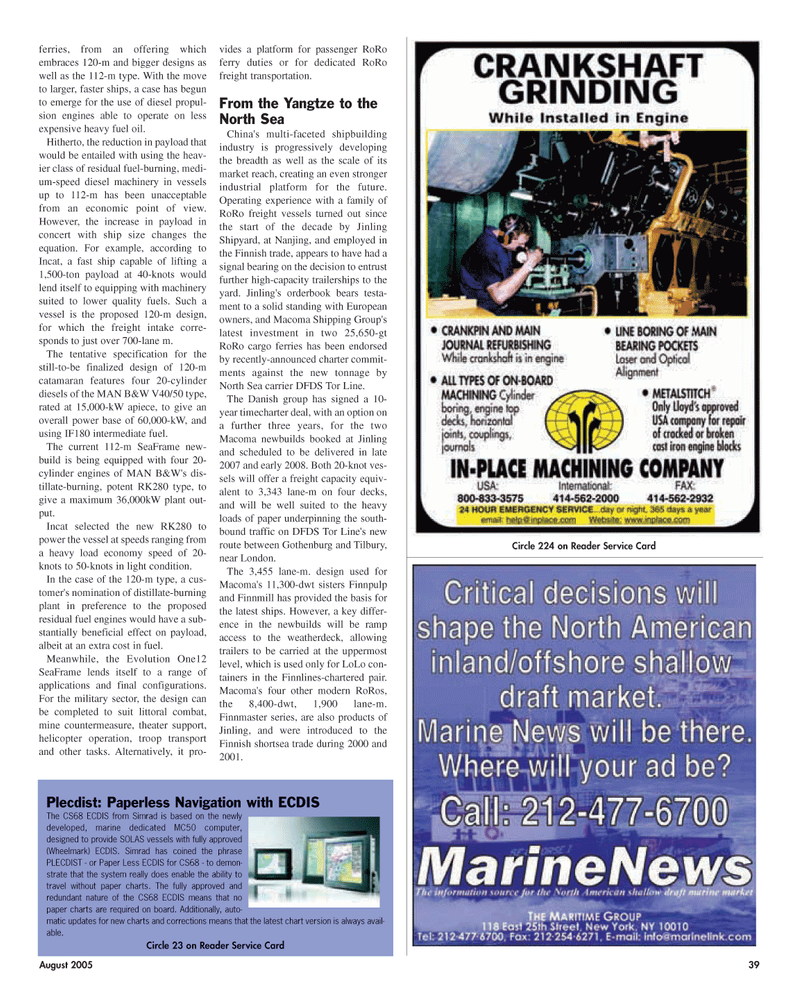
Page 39: of Maritime Reporter Magazine (August 2005)
AWO Edition: Inland & Offshore Waterways
Read this page in Pdf, Flash or Html5 edition of August 2005 Maritime Reporter Magazine
August 2005 39 ferries, from an offering which embraces 120-m and bigger designs as well as the 112-m type. With the move to larger, faster ships, a case has begun to emerge for the use of diesel propul- sion engines able to operate on less expensive heavy fuel oil.
Hitherto, the reduction in payload that would be entailed with using the heav- ier class of residual fuel-burning, medi- um-speed diesel machinery in vessels up to 112-m has been unacceptable from an economic point of view.
However, the increase in payload in concert with ship size changes the equation. For example, according to
Incat, a fast ship capable of lifting a 1,500-ton payload at 40-knots would lend itself to equipping with machinery suited to lower quality fuels. Such a vessel is the proposed 120-m design, for which the freight intake corre- sponds to just over 700-lane m.
The tentative specification for the still-to-be finalized design of 120-m catamaran features four 20-cylinder diesels of the MAN B&W V40/50 type, rated at 15,000-kW apiece, to give an overall power base of 60,000-kW, and using IF180 intermediate fuel.
The current 112-m SeaFrame new- build is being equipped with four 20- cylinder engines of MAN B&W's dis- tillate-burning, potent RK280 type, to give a maximum 36,000kW plant out- put.
Incat selected the new RK280 to power the vessel at speeds ranging from a heavy load economy speed of 20- knots to 50-knots in light condition.
In the case of the 120-m type, a cus- tomer's nomination of distillate-burning plant in preference to the proposed residual fuel engines would have a sub- stantially beneficial effect on payload, albeit at an extra cost in fuel.
Meanwhile, the Evolution One12
SeaFrame lends itself to a range of applications and final configurations.
For the military sector, the design can be completed to suit littoral combat, mine countermeasure, theater support, helicopter operation, troop transport and other tasks. Alternatively, it pro- vides a platform for passenger RoRo ferry duties or for dedicated RoRo freight transportation.
From the Yangtze to the
North Sea
China's multi-faceted shipbuilding industry is progressively developing the breadth as well as the scale of its market reach, creating an even stronger industrial platform for the future.
Operating experience with a family of
RoRo freight vessels turned out since the start of the decade by Jinling
Shipyard, at Nanjing, and employed in the Finnish trade, appears to have had a signal bearing on the decision to entrust further high-capacity trailerships to the yard. Jinling's orderbook bears testa- ment to a solid standing with European owners, and Macoma Shipping Group's latest investment in two 25,650-gt
RoRo cargo ferries has been endorsed by recently-announced charter commit- ments against the new tonnage by
North Sea carrier DFDS Tor Line.
The Danish group has signed a 10- year timecharter deal, with an option on a further three years, for the two
Macoma newbuilds booked at Jinling and scheduled to be delivered in late 2007 and early 2008. Both 20-knot ves- sels will offer a freight capacity equiv- alent to 3,343 lane-m on four decks, and will be well suited to the heavy loads of paper underpinning the south- bound traffic on DFDS Tor Line's new route between Gothenburg and Tilbury, near London.
The 3,455 lane-m. design used for
Macoma's 11,300-dwt sisters Finnpulp and Finnmill has provided the basis for the latest ships. However, a key differ- ence in the newbuilds will be ramp access to the weatherdeck, allowing trailers to be carried at the uppermost level, which is used only for LoLo con- tainers in the Finnlines-chartered pair.
Macoma's four other modern RoRos, the 8,400-dwt, 1,900 lane-m.
Finnmaster series, are also products of
Jinling, and were introduced to the
Finnish shortsea trade during 2000 and 2001.
Circle 224 on Reader Service Card
Plecdist: Paperless Navigation with ECDIS
The CS68 ECDIS from Simrad is based on the newly developed, marine dedicated MC50 computer, designed to provide SOLAS vessels with fully approved (Wheelmark) ECDIS. Simrad has coined the phrase
PLECDIST - or Paper Less ECDIS for CS68 - to demon- strate that the system really does enable the ability to travel without paper charts. The fully approved and redundant nature of the CS68 ECDIS means that no paper charts are required on board. Additionally, auto- matic updates for new charts and corrections means that the latest chart version is always avail- able.
Circle 23 on Reader Service Card
MR AUGUST 2005 #5 (33-40).qxd 8/4/2005 9:04 PM Page 39

 38
38

 40
40
